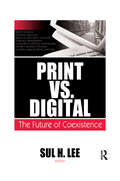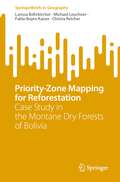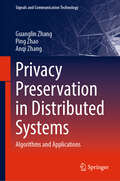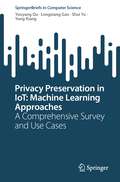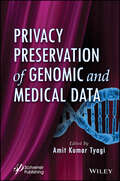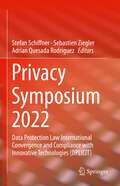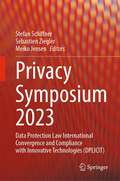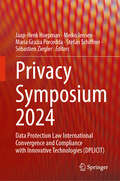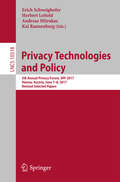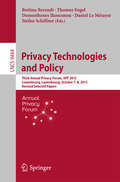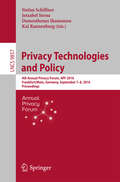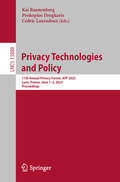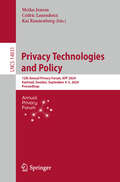- Table View
- List View
Principles of Verilog Digital Design
by Wen-Long ChinCovering both the fundamentals and the in-depth topics related to Verilog digital design, both students and experts can benefit from reading this book by gaining a comprehensive understanding of how modern electronic products are designed and implemented. Principles of Verilog Digital Design contains many hands-on examples accompanied by RTL codes that together can bring a beginner into the digital design realm without needing too much background in the subject area. This book has a particular focus on how to transform design concepts into physical implementations using architecture and timing diagrams. Common mistakes a beginner or even an experienced engineer can make are summarized and addressed as well. Beyond the legal details of Verilog codes, the book additionally presents what uses Verilog codes have through some pertinent design principles. Moreover, students reading this book will gain knowledge about system-level design concepts. Several ASIC designs are illustrated in detail as well. In addition to design principles and skills, modern design methodology and how it is carried out in practice today are explored in depth as well.
Principles of Web Design: Understanding The Principles Of Successful Web Site Design
by Brian D. MillerLearn everything there is to know, from project planning through marketing and analytics, about Web design!Principles of Web Design is a book about the fundamentals of clear graphic communication within the context of Web design. Author Brian D. Miller is a sought-after expert in developing product and digital branding strategies for emerging startups and Fortune 500 organizations. In Principles of Web Design, he will teach the reader the tricks of the trade and everything one should know about web design through easy, step-by-step guides and with full-color illustrations. The book has three sections, which follow the cycle of a typical Web project: PLAN: This section focuses on the predesign phase of a Web project. Everything from project planning and brief writing to information architecture and responsive grid creation will be covered.DESIGN: The second section of Priciples of Web Design explores the enduring principles of design and the nuances that are specific to the field of Web design. OPTIMIZE: Finally, we close the loop and discover ways to enable your client to maximize the investment they&’ve made in their Web site with marketing and analytics.
Principles of Wireless Sensor Networks
by Sudip Misra Mohammad S. ObaidatWireless sensor networks are an emerging technology with a wide range of applications in military and civilian domains. The book begins by detailing the basic principles and concepts of wireless sensor networks, including information gathering, energy management and the structure of sensory nodes. It proceeds to examine advanced topics, covering localisation, topology, security and evaluation of wireless sensor networks, highlighting international research being carried out in this area. Finally, it features numerous examples of applications of this technology to a range of domains, such as wireless, multimedia, underwater and underground wireless sensor networks. The concise but clear presentation of the important principles, techniques and applications of wireless sensor networks makes this guide an excellent introduction for anyone new to the subject, as well as an ideal reference for practitioners and researchers.
Print Reading for Welding and Fabrication
by Kevin CorganPRINT READING FOR WELDING AND FABRICATION, First Edition, offers students a simple, logical, easy-to-understand path to reading and understanding the drawings that are most commonly found in the welding and fabrication industries. Each chapter clearly presents objectives and key terms, and offers practical exercises. Each chapter also provides a supplement with bite-size, easy-to-follow explanations of the mathematics that welders need in order to successfully interpret prints. Throughout, the author emphasizes the codes, standards, and industrial practices students will be most likely to encounter. Concepts and terminology from the American Welding Society (AWS) and The Society of Mechanical Engineers (ASME) are used throughout.
Print vs. Digital: The Future of Coexistence (Monographs From The Journal Of Library Administration Ser.)
by Sul H. LeeLibraries are currently confronted by the challenges of managing increasing amounts of electronic information. Print vs. Digital: The Future of Coexistence presents the expert perspectives of eight of America’s leading library administrators on ways to effectively manage digital flow and offers strategies to provide a level of coexistence between digital and print information. This excellent overview explores how to best balance print and electronic resources, and explores important issues such as the selection of electronic resources, improving access to digital information for a larger user base, and effective management of a library’s fiscal and personnel resources. Print vs. Digital: The Future of Coexistence discusses the various challenges libraries now face from the massive influx of digital resources, including the ways that information-seeking behaviors have changed, the search for synergies between print and digital, economics of news preservation, and whether or not the end of print journals is at hand. New ideas and technological advances are explored, including the diverse ways these improvements will impact the future. This well-referenced resource includes useful tables, figures, and photographs. Topics in Print vs. Digital: The Future of Coexistence include: cooperative collection development balance of print and electronic resources evolvement of digital resources in libraries change in research libraries factors influencing the selection of electronic resources disseminating information about scholarly collections impact of digital resources on research behavior and techniques design of digital libraries JSTOR effects of digital information on reference collections transition of print journals to digital formats Print vs. Digital: The Future of Coexistence is a thought provoking, insightful resource on the future of libraries, invaluable for acquisitions, reference, and collection development librarians; and senior and mid-level administrators such as deans, directors, and department heads for public, special, and academic libraries.
Printed Antennas for 5G Networks (PoliTO Springer Series)
by Jugul Kishor Binod Kumar Kanaujia Surendra Kumar Gupta Ladislau MatekovitsThe book provides a comprehensive overview of antennas for 5G technology, such as MIMO, multiband antennas, Magneto-Electric Dipole Antenna and PIFA Antenna for 5G networks, phased array antennas for 5G access, beam-forming and beam-steering issues, 5G antennas for specific applications (smartphone, cognitive radio) and advance antenna concept and materials for 5G. The book also covers ooptimizations methods for passive and active devices in mm-Wave 5G networks. It explores topics which influence the design and characterization of antennas such as data rates, high isolation, pattern and spatial diversity, making 5G antennas more suitable for a multipath environment. The book represents a learning tool for researchers in the field, and enables engineers, designers and manufacturers to identify key design challenges of antennas for 5G networks, and characterize novel antennas for 5G networks.
Printing with Adobe Photoshop CS4
by Tim DalyPhotoshop users:Ever feel like your printer is letting you down? Sick of seeing the bright, saturated tones of photos on your monitor turn into washed-out, drab prints? Frustrated by the lack of resources on this essential process?If the answer to any of these questions is yes, then you really need "The Complete Guide to Digital Printing" by Tim Daly. This essential resource is the only guide you'll ever need to printing with Photoshop. Acclaimed author and photographer Tim Daly brings a wealth of experience to this under-resourced topic, covering every aspect of the printing process using Photoshop. Not content with simply covering the software, Tim approaches the entire workflow. This means that right from the moment of capture, your photos are optimised for the highest print quality from Photoshop. Topics covered include image capture and management, file processing, creative emphasis, proofing, Photoshop print functions, color management (both input and output), printer hardware and software, and, of course, the actual printing. Buy this book, and see an immediate difference to the quality of your prints. Authoritative, practical and comprehensive, this is a must-have for every photographer using Photoshop.
Printreading for Residential Construction, Sixth Edition
by Thomas E. Proctor Leonard P. ToenjesPrintreading for Residential Constructionpresents printreading fundamentals and provides printreading activities related to residential construction. Topics presented include sketching, computer-aided design (CAD), trade math symbols and abbreviations, plot plans, floor plans, elevations, sections, and details. This new edition provides information on revised building codes, LEED for Homes, green building practices, advanced house framing techniques, insulation, and the whole-house systems approach. Content Overview Construction Documents Working Drawing Concepts Trade Math Symbols and Abbreviations Plot Plans Floor Plans Elevations Sections Details Trade Information - Foundations, Framing, and Finishes Trade Information - Electrical, Plumbing, and HVAC Final Review and Exams Appendix Glossary Index
Priority-Zone Mapping for Reforestation: Case Study in the Montane Dry Forests of Bolivia (SpringerBriefs in Geography)
by Christa Reicher Michael Leuchner Larissa Böhrkircher Fabio Bayro KaiserAndean dry forest ecosystems are threatened by deforestation and unsustainable land use methods. The negative effects for the livelihood of the local population, biodiversity, and the regional climate could be countered by reforestation measures; however, dry land forests have not attracted the same level of interest and investment like other ecosystems. This book describes the development of a priority-zone map for reforestation measures, showing where reforestation might have the greatest social and ecological benefits. To achieve this, a problem analysis of a case study region is conducted and thematic reforestation benefits are determined. Using remote sensing and GIS, the areas where benefits can be obtained are mapped in individual layers and compiled into a summarizing priority-zone map. It is thus possible to identify areas where reforestation would achieve multiple benefits. The concept of priority maps could be used to facilitate reforestation strategies by local communities and municipal governments and could thus contribute to initiate an integrated forest and landscape restoration of the Bolivian montane dry forests.
Privacidad es poder: Datos, vigilancia y libertad en la era digital
by Carissa VélizSeleccionado por The Economist como uno de los libros del año. La guía definitiva para afrontar uno de los problemas más acuciantes de nuestro tiempo: la pérdida de la privacidad. Nos vigilan. Saben que estás leyendo estas palabras. Gobiernos y cientos de empresas nos espían: a ti y a todos tus conocidos. A todas horas, todos los días. Rastrean y registran todo lo que pueden: nuestra ubicación, nuestras comunicaciones, nuestras búsquedas en internet, nuestra información biométrica, nuestras relaciones sociales, nuestras compras, nuestros problemas médicos y mucho más. Quieren saber quiénes somos, qué pensamos, dónde nos duele. Quieren predecir nuestro comportamiento e influir en él. Tienen demasiado poder. Su poder proviene de nosotros, de ti, de tus datos. Recuperar la privacidad es la única manera de que podamos asumir de nuevo el mando de nuestras vidas y de nuestras sociedades. La privacidad es tan colectiva como personal, y es hora de retomar el control. Privacidad es poder es el primer libro que propone el fin de la economía de los datos. Carissa Véliz explica cómo nuestros datos personales están cediendo demasiado poder a las grandes empresas tecnológicas y a los gobiernos, por qué esto es importante y qué podemos hacer al respecto.
Privacy Computing: Theory and Technology
by Fenghua Li Ben Niu Hui LiThe continuous evolution and widespread application of communication technology, network technology and computing technology have promoted the intelligent interconnection of all things and ubiquitous sharing of information. The cross-border, cross-system, and cross-ecosystem exchange of user data has become commonplace. At the same time, difficulties in the prevention of private information abuse and lack of protection methods have become global problems. As such, there is an urgent need to intensify basic theoretical research in this field to support the protection of personal information in a ubiquitously interconnected environment. The authors of this book proposed the concept, definition and research scope of privacy computing for the first time in 2015. This book represents their original and innovative scientific research achievement dedicated to privacy computing research, and systematically explains the basic theory and technology involved. It introduces readers to the connection between personal information and privacy protection, defines privacy protection and privacy desensitization, clarifies and summarizes the limitations of existing privacy-preserving technologies in practical information system applications, analyzes the necessity of conducting privacy computing research, and proposes the concept, definition and research scope of privacy computing. It comprehensively expounds the theoretical system of privacy computing and some privacy-preserving algorithms based on the idea of privacy computing. In closing, it outlines future research directions.
Privacy Is Hard and Seven Other Myths: Achieving Privacy through Careful Design
by Jaap-Henk HoepmanAn expert on computer privacy and security shows how we can build privacy into the design of systems from the start.We are tethered to our devices all day, every day, leaving data trails of our searches, posts, clicks, and communications. Meanwhile, governments and businesses collect our data and use it to monitor us without our knowledge. So we have resigned ourselves to the belief that privacy is hard--choosing to believe that websites do not share our information, for example, and declaring that we have nothing to hide anyway. In this informative and illuminating book, a computer privacy and security expert argues that privacy is not that hard if we build it into the design of systems from the start. Along the way, Jaap-Henk Hoepman debunks eight persistent myths surrounding computer privacy. The website that claims it doesn't collect personal data, for example; Hoepman explains that most data is personal, capturing location, preferences, and other information. You don't have anything to hide? There's nothing wrong with wanting to keep personal information--even if it's not incriminating or embarrassing--private. Hoepman shows that just as technology can be used to invade our privacy, it can be used to protect it, when we apply privacy by design. Hoepman suggests technical fixes, discussing pseudonyms, leaky design, encryption, metadata, and the benefits of keeping your data local (on your own device only), and outlines privacy design strategies that system designers can apply now.
Privacy Online
by Sabine Trepte Leonard ReineckeCommunications and personal information that are posted online are usually accessible to a vast number of people. Yet when personal data exist online, they may be searched, reproduced and mined by advertisers, merchants, service providers or even stalkers. Many users know what may happen to their information, while at the same time they act as though their data are private or intimate. They expect their privacy will not be infringed while they willingly share personal information with the world via social network sites, blogs, and in online communities. The chapters collected by Trepte and Reinecke address questions arising from this disparity that has often been referred to as the privacy paradox. Works by renowned researchers from various disciplines including psychology, communication, sociology, and information science, offer new theoretical models on the functioning of online intimacy and public accessibility, and propose novel ideas on the how and why of online privacy. The contributing authors offer intriguing solutions for some of the most pressing issues and problems in the field of online privacy. They investigate how users abandon privacy to enhance social capital and to generate different kinds of benefits. They argue that trust and authenticity characterize the uses of social network sites. They explore how privacy needs affect users' virtual identities. Ethical issues of privacy online are discussed as well as its gratifications and users' concerns. The contributors of this volume focus on the privacy needs and behaviors of a variety of different groups of social media users such as young adults, older users, and genders. They also examine privacy in the context of particular online services such as social network sites, mobile internet access, online journalism, blogs, and micro-blogs. In sum, this book offers researchers and students working on issues related to internet communication not only a thorough and up-to-date treatment of online privacy and the social web. It also presents a glimpse of the future by exploring emergent issues concerning new technological applications and by suggesting theory-based research agendas that can guide inquiry beyond the current forms of social technologies.
Privacy Preservation in Distributed Systems: Algorithms and Applications (Signals and Communication Technology)
by Anqi Zhang Ping Zhao Guanglin ZhangThis book provides a discussion of privacy in the following three parts: Privacy Issues in Data Aggregation; Privacy Issues in Indoor Localization; and Privacy-Preserving Offloading in MEC. In Part 1, the book proposes LocMIA, which shifts from membership inference attacks against aggregated location data to a binary classification problem, synthesizing privacy preserving traces by enhancing the plausibility of synthetic traces with social networks. In Part 2, the book highlights Indoor Localization to propose a lightweight scheme that can protect both location privacy and data privacy of LS. In Part 3, it investigates the tradeoff between computation rate and privacy protection for task offloading a multi-user MEC system, and verifies that the proposed load balancing strategy improves the computing service capability of the MEC system. In summary, all the algorithms discussed in this book are of great significance in demonstrating the importance of privacy.
Privacy Preservation in IoT: A Comprehensive Survey and Use Cases (SpringerBriefs in Computer Science)
by Shui Yu Longxiang Gao Yong Xiang Youyang QuThis book aims to sort out the clear logic of the development of machine learning-driven privacy preservation in IoTs, including the advantages and disadvantages, as well as the future directions in this under-explored domain. In big data era, an increasingly massive volume of data is generated and transmitted in Internet of Things (IoTs), which poses great threats to privacy protection. Motivated by this, an emerging research topic, machine learning-driven privacy preservation, is fast booming to address various and diverse demands of IoTs. However, there is no existing literature discussion on this topic in a systematically manner. The issues of existing privacy protection methods (differential privacy, clustering, anonymity, etc.) for IoTs, such as low data utility, high communication overload, and unbalanced trade-off, are identified to the necessity of machine learning-driven privacy preservation. Besides, the leading and emerging attacks pose further threats to privacy protection in this scenario. To mitigate the negative impact, machine learning-driven privacy preservation methods for IoTs are discussed in detail on both the advantages and flaws, which is followed by potentially promising research directions. Readers may trace timely contributions on machine learning-driven privacy preservation in IoTs. The advances cover different applications, such as cyber-physical systems, fog computing, and location-based services. This book will be of interest to forthcoming scientists, policymakers, researchers, and postgraduates.
Privacy Preservation of Genomic and Medical Data
by Amit Kumar TyagiPRIVACY PRESERVATION of GENOMIC and MEDICAL DATA Discusses topics concerning the privacy preservation of genomic data in the digital era, including data security, data standards, and privacy laws so that researchers in biomedical informatics, computer privacy and ELSI can assess the latest advances in privacy-preserving techniques for the protection of human genomic data. Privacy Preservation of Genomic and Medical Data focuses on genomic data sources, analytical tools, and the importance of privacy preservation. Topics discussed include tensor flow and Bio-Weka, privacy laws, HIPAA, and other emerging technologies like Internet of Things, IoT-based cloud environments, cloud computing, edge computing, and blockchain technology for smart applications. The book starts with an introduction to genomes, genomics, genetics, transcriptomes, proteomes, and other basic concepts of modern molecular biology. DNA sequencing methodology, DNA-binding proteins, and other related terms concerning genomes and genetics, and the privacy issues are discussed in detail. The book also focuses on genomic data sources, analyzing tools, and the importance of privacy preservation. It concludes with future predictions for genomic and genomic privacy, emerging technologies, and applications. Audience Researchers in information technology, data mining, health informatics and health technologies, clinical informatics, bioinformatics, security and privacy in healthcare, as well as health policy developers in public and private health departments and public health.
Privacy Symposium 2022: Data Protection Law International Convergence and Compliance with Innovative Technologies (DPLICIT)
by Stefan Schiffner Sebastien Ziegler Adrian Quesada RodriguezThis book presents a collection of high-quality research works and professional perspectives arising from the call for papers of the Privacy Symposium 2022; an international conference aimed towards the promotion of international dialogue, cooperation and knowledge sharing on data protection regulations, compliance and emerging technologies. Gathering legal and technology expertise, this publication provides cutting-edge perspectives on the convergence of international data protection regulations, as well as data protection compliance of emerging technologies, such as: Artificial Intelligence, e-health, blockchain, edge computing, Internet of things, V2X and Smart Grids. It includes selected papers from the Privacy Symposium conference 2022 (PSC 2022) call for papers, encompassing relevant topics, including: international law and comparative law in data protection cross-border data transfers emerging technologies and data protection compliance data protection by design technologic solutions for data protection compliance data protection good practices across industries and verticals cybersecurity and data protection assessment and certification of data protection compliance, and data subject rights implementation This publication includes papers authored by academics and professionals involved on various areas of data protection, technical, legal and compliance services.Chapter 10 is available open access under a Creative Commons Attribution 4.0 International License via link.springer.com
Privacy Symposium 2023: Data Protection Law International Convergence and Compliance with Innovative Technologies (DPLICIT)
by Stefan Schiffner Sébastien Ziegler Meiko JensenThis book presents the proceedings of the Privacy Symposium 2023. the book features a collection of high-quality research works and professional perspectives on personal data protection and emerging technologies. Gathering legal and technology expertise, it provides cutting-edge perspective on international data protection regulations convergence, as well as data protection compliance of emerging technologies, such as artificial intelligence, e-health, blockchain, edge computing, Internet of Things, V2X and smart grid. Papers encompass various topics, including international law and comparative law in data protection and compliance, cross-border data transfer, emerging technologies and data protection compliance, data protection by design, technology for compliance and data protection, data protection good practices across industries and verticals, cybersecurity and data protection, assessment and certification of data protection compliance, and data subject rights implementation.
Privacy Symposium 2024: Data Protection Law International Convergence and Compliance with Innovative Technologies (DPLICIT)
by Stefan Schiffner Jaap-Henk Hoepman Sébastien Ziegler Maria Grazia Porcedda Meiko JensenThis book presents the proceedings of the Privacy Symposium 2024. The book features a collection of high-quality research works and professional perspectives on personal data protection and emerging technologies. Gathering legal and technology expertise, it provides cutting-edge perspective on international data protection regulations convergence, as well as data protection compliance of emerging technologies, such as artificial intelligence, e-health, blockchain, edge computing, Internet of Things, V2X, and smart grid. Papers encompass various topics, including international law and comparative law in data protection and compliance, cross-border data transfer, emerging technologies and data protection compliance, data protection by design, technology for compliance and data protection, data protection good practices across industries and verticals, cybersecurity and data protection, assessment and certification of data protection compliance, and data subject rights implementation.
Privacy Technologies and Policy: 10th Annual Privacy Forum, APF 2022, Warsaw, Poland, June 23–24, 2022, Proceedings (Lecture Notes in Computer Science #13279)
by Kai Rannenberg Nils Gruschka Agnieszka Gryszczyńska Przemysław Polański Monika AdamczykThis book constitutes the refereed conference proceedings of the 10th Annual Privacy Forum, APF 2022 in Warsaw, Poland in June 2022. The 8 full papers were carefully reviewed and selected from 38 submissions. The papers are organized in the area of privacy and data protection while focusing on privacy related application areas. A large focus of the 2022 conference was on the General Data Protection Regulation (GDPR).
Privacy Technologies and Policy
by Kai Rannenberg Erich Schweighofer Herbert Leitold Andreas MitrakasThis book constitutes the thoroughly refereed post-conference proceedings of the 5th Annual Privacy Forum, APF 2017, held in Vienna, Austria, in June 2017. The 12 revised full papers were carefully selected from 41 submissions on the basis of significance, novelty, and scientific quality. These selected papers are organized in three different chapters corresponding to the conference sessions. The first chapter, "Data Protection Regulation", discusses topics concerning big genetic data, a privacy-preserving European identity ecosystem, the right to be forgotten und the re-use of privacy risk analysis. The second chapter, "Neutralisation and Anonymization", discusses neutralisation of threat actors, privacy by design data exchange between CSIRTs, differential privacy and database anonymization. Finally, the third chapter, "Privacy Policies in Practice", discusses privacy by design, privacy scores, privacy data management in healthcare and trade-offs between privacy and utility.
Privacy Technologies and Policy
by Bettina Berendt Thomas Engel Demosthenes Ikonomou Daniel Le Métayer Stefan SchiffnerThis book constitutes the thoroughly refereedpost-conference proceedings of the Third Annual Privacy Forum, APF 2015, heldin Luxembourg, Luxembourg, in October 2015. The 11 revised full papers presented in this volume werecarefully reviewed and selected from 24 submissions. The topics focus onprivacy by design (PbD), i. e. the attempt to combine technical and organizationalmeasures to ensure the basic rights of the individual. The papers are organizedin three sessions: measuring privacy; rules and principles; legal and economicperspectives on privacy.
Privacy Technologies and Policy
by Demosthenes Ikonomou Stefan Schiffner Jetzabel Serna Kai RannenbergThis book constitutes the refereed proceedings of the Second Annual Privacy Forum, APF 2014, held in Athens, Greece, in May 2014. The 12 revised papers presented in this volume were carefully reviewed and selected from 21 submissions. The topics include: the concept and implementation of "privacy by design", with applications to encrypted databases; the study of video surveillance architectures and new networking concepts and innovative solutions for identity management. The papers address the technical, legal, and economic aspects of these problems.
Privacy Technologies and Policy: 11th Annual Privacy Forum, APF 2023, Lyon, France, June 1–2, 2023, Proceedings (Lecture Notes in Computer Science #13888)
by Kai Rannenberg Prokopios Drogkaris Cédric LauradouxThis book constitutes the refereed conference proceedings of the 11th Annual Privacy Forum, APF 2023 in Lyon, France in June 2023. The 8 full papers were carefully reviewed and selected from 37 submissions. The papers are organized in the following topical sections: Emerging Technologies and Protection of Personal Data, Data Protection Principles and Data Subject Rights, Modelling Data Protection and Privacy, and Modelling Perceptions of Privacy.
Privacy Technologies and Policy: 12th Annual Privacy Forum, APF 2024, Karlstad, Sweden, September 4–5, 2024, Proceedings (Lecture Notes in Computer Science #14831)
by Kai Rannenberg Meiko Jensen Cédric LauradouxThis book constitutes the refereed proceedings of the 12th Annual Privacy Forum on Privacy Technologies and Policy, APF 2024, held in Karlstad, Sweden, during September 4–5, 2024. The 12 full papers were carefully reviewed and selected from 60 submissions. This conference was established as an opportunity to bring together key communities, namely policy, academia, and industry, in the broader area of privacy and data protection while focusing on privacy-related application areas. Like in the previous edition, a large focus of the 2024 conference was on the General Data Protection Regulation (GDPR) and the emerging legislation around the European Data Spaces and Arti cial Intelligence. Chapter 3, 9, 12 are licensed under the terms of the Creative Commons Attribution 4.0 International License (http://creativecommons.org/licenses/by/4.0/). For further details see license information in the chapter.




